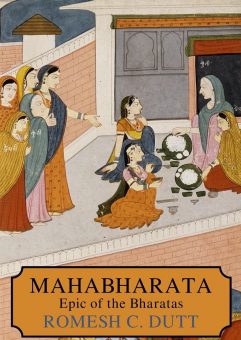insulters; the calm beauty of the forest life of the Pandavs; the cattle-lifting in Matsyaland in which the gallant Arjun threw off his disguise and stood forth as warrior and conqueror; and the Homeric speeches of the warriors in the council of war on the eve of the great contest, – each scene of this venerable old Epic impresses itself on the mind of the hushed and astonished reader. Then follows the war of eighteen days. The first few days are more or less uneventful, and have been condensed in this translation often into a few couplets; but the interest of the [380] reader increases as he approaches the final battle and fall of the grand old fighter Bhishma. Then follows the stirring story of the death of Arjun’s gallant boy, and Arjun’s fierce revenge, and the death of the priest and warrior, doughty Drona. Last comes the crowning event of the Epic, the final contest between Arjun and Karna, the heroes of the Epic, and the war ends in a midnight slaughter and the death of Duryodhan. The rest of the story is told in this translation in two books describing the funerals of the deceased warriors, and Yudhishthir’a horse-sacrifice.
“The poems of Homer,” says Mr. Gladstone, “differ from all other known poetry in this that they constitute in themselves an encyclopaedia of life and knowledge; at a time when knowledge, indeed, such as lies beyond the bounds of actual experience, was extremely limited, and when life was singularly fresh, vivid, and expansive.” This remark applies with even greater force to the Maha- bharata; it is an encyclopaedia of the life and knowledge of Ancient India. And it discloses to us an ancient and forgotten world, a proud and noble civilisation which has passed away. Northern India was then parcelled among warlike races living side by side under their warlike kings, speaking the same language, performing the same religious rites and ceremonies, rejoicing in a common literature, rivalling each other in their schools of philosophy and learning as in the arts of peace and civilisation, and forming a confederation of Hindu nations unknown to, and unknowing the outside world. What this confederation of nations has done for the cause of human knowledge and human civilisation is a matter of history. Their inquiries into the hidden truths of religion, embalmed in the ancient Upanishads, have never been excelled within the last three thousand years. Their inquiries into philosophy, preserved in the Sankhya and the Vedanta systems, were the first systems of true philosophy which the world produced. And their great works of imagination, the Maha-bharata and the Ramayana will be placed without hesitation by the side of Homer by critics who survey the world’s literatures from a lofty standpoint, and judge impartially of the wares turned out by the hand of man in all parts of the globe. It is scarcely necessary to add [381] that the discoveries of the ancient Hindus in science, and specially in mathematics, are the heritage of the modern world; and that the lofty religion of Buddha, proclaimed in India five centuries before Christ, is now the religion of a third of the human race.
For the rest, the people of modern India know how to appreciate their ancient heritage. It is not an exaggeration to state that the two hundred millions of Hindus of the present day cherish in their hearts the story of their ancient Epics.
The Hindu scarcely lives, man or woman, high or low, educated or ignorant, whose earliest recollections do not cling round the story and the characters of the great Epics. The almost illiterate oil-manufacturer or confectioner of Bengal spells out some modern translation of the Maha-bharata to while away his leisure hour. The tall and stalwart peasantry of the North-West know of the five Pandav brothers, and of their friend the righteous Krishna. The people of Bombay and Madras cherish with equal ardour the story of the righteous war. And even the traditions and tales interspersed in the Epic, and which spoil the work as an Epic, have themselves a charm and an attraction; and the morals inculcated in these tales sink into the hearts of a naturally religious people, and form the basis of their moral education. Mothers in India know no better theme for imparting wisdom and instruction to their daughters, and elderly men know no richer storehouse for narrating tales to children, than these stories preserved in the Epics. No work in Europe, not Homer in Greece or Virgil in Italy, not Shakespeare or Milton in English-speaking lands, is the national property of the nations to the same extent as the Epics of India are of the Hindus. No single work except the Bible has such influence in affording moral instruction in Christian lands as the Maha-bharata and the Ramayana in India. They have been the cherished heritage of the Hindus for three thousand years; they are to the present day interwoven with the thoughts and beliefs and moral ideas of a nation numbering two hundred millions.
Romesh Dutt.
University College, London,
13th August 1898
Pages: 1 2 3 4 5 6 7 8 9 10 11 12 13 14 15 16 17 18 19 20 21 22 23 24 25 26 27 28 29 30 31 32 33 34 35 36 37 38 39 40 41 42 43 44 45 46 47 48 49 50 51 52 53 54 55 56 57 58 59 60 61 62 63 64 65 66 67 68 69 70 71 72 73 74 75 76 77 78 79 80 81




